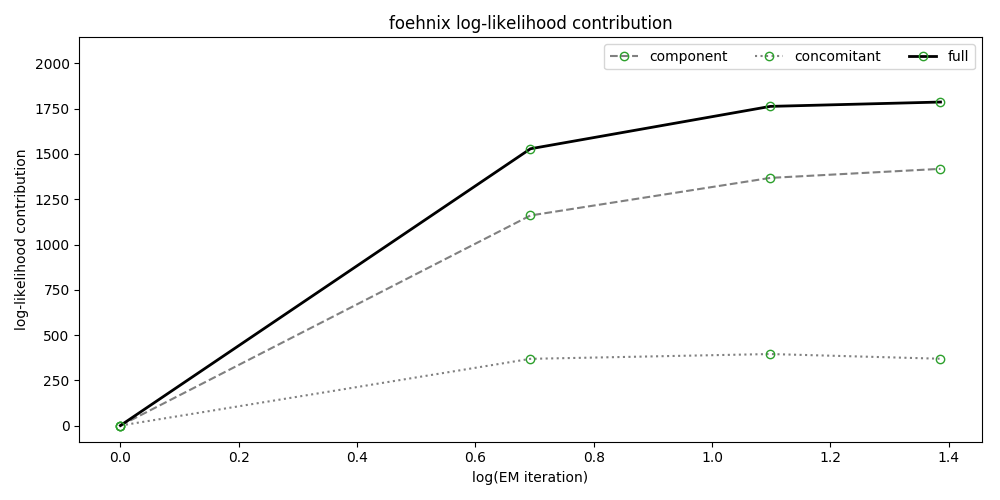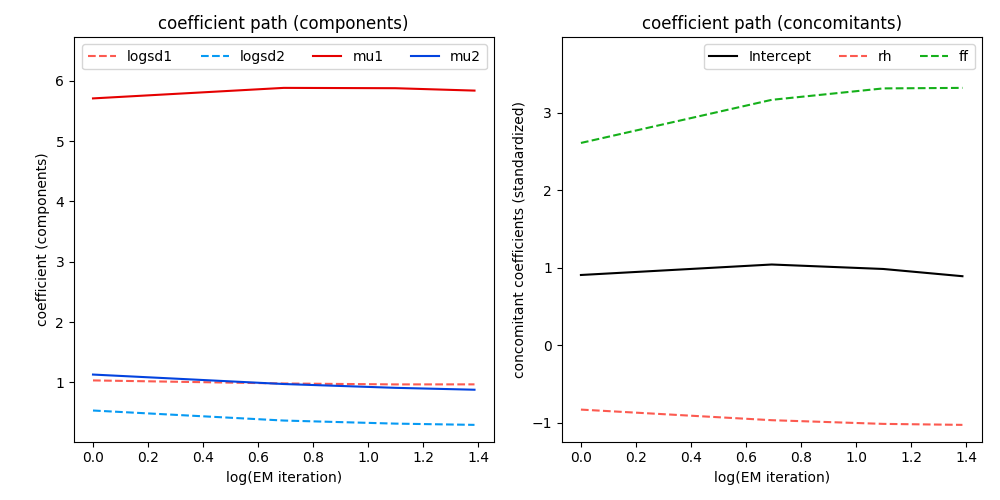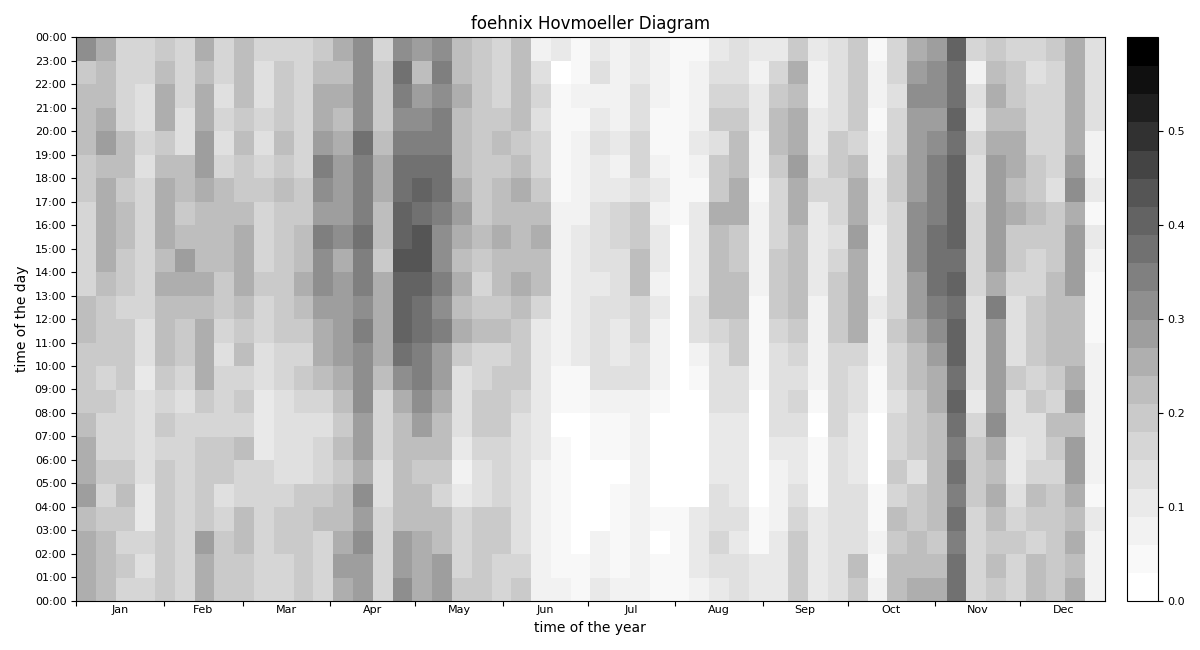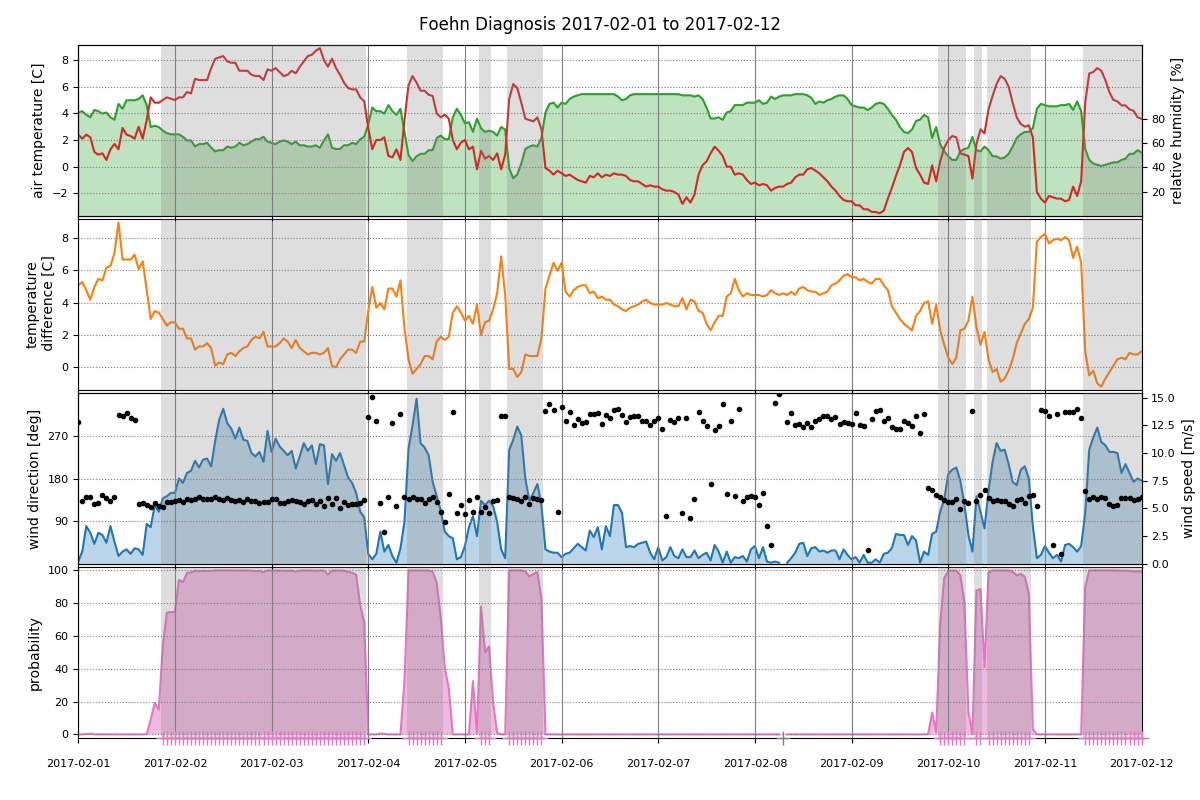Data Set Description¶
The “Tyrolean” data set provides hourly observations from two stations, namely “Ellbögen” and “Sattelberg” located in Tyrol, Austria.
Ellbögen is our target station (valley site) located in the Wipp Valley, a north-south oriented alpine valley on the northern side of the European Alps. To the north the Wipp Valley opens into the Inn Valley (close to Innsbruck, the capitol of Tyrol), to the south the valley ends at a narrow gap in the main Alpine ridge called Brennerpass (\(1370~m\); the pass between Austria and Italy) flanked by mountains (\(>2100~m\)). The Wipp Valley is one of the lowest and most distinct cuts trough the Alpine mountain range and well known for south foehn (north of the Alps). Station Sattelberg serves as crest station and provides observations of the upstream air mass during south foehn events. The station is located on top of the mountain to the west of the pass.
Loading the Data Set¶
The call
foehnix.get_demodata('tyrol')
returns the combined
data set for both station (Ellbögen and Sattelberg).
In addition, the potential temperature difference between the two stations
is calculated by reducing the dry air temperature from “Sattelberg”
to the height of “Ellbögen” (dry adiabatic lapse rate of 1K per 100m;
stored on diff_t).
Details can be found on the
get_demodata()
reference page.
In [1]: import numpy as np
In [2]: import foehnix
# load the data for Tyrol and show a summary:
In [3]: data = foehnix.get_demodata('tyrol')
In [4]: data.head()
Out[4]:
timestamp dd ff rh t dd_crest ff_crest rh_crest t_crest diff_t
timestamp
2006-01-01 01:00:00 1136077200 171.0 0.6 90.0 -0.4 180.0 10.8 100.0 -7.8 2.87
2006-01-01 02:00:00 1136080800 268.0 0.3 100.0 -1.8 186.0 12.5 100.0 -8.0 4.07
2006-01-01 03:00:00 1136084400 115.0 5.2 79.0 0.9 181.0 11.3 100.0 -7.4 1.97
2006-01-01 04:00:00 1136088000 152.0 2.1 88.0 -0.6 178.0 13.3 100.0 -7.5 3.37
2006-01-01 05:00:00 1136091600 319.0 0.7 100.0 -2.6 176.0 13.1 100.0 -7.1 5.77
The data set returned is a regular pandas.DataFrame object.
Note that the data set is not strictly regular (contains hourly observations,
but some are missing) and contains quite some missing values (NaN).
This is not a problem as the functions and methods will take care of missing
values and inflate the time series object
(regular \(\rightarrow\) strictly regular).
Important: The names of the variables in the Tyrolean data set are the “standard names” on which most functions and methods provided by this package are based on. To be precise:
- Valley station: air temperature
t, relative humidityrh, wind speedff, wind directiondd(meteorological, degrees \(\in [0, 360]\)) - Crest station: air temperature
t_crest, relative humidityrh_crest, wind speedff_crest, wind directiondd_crest(\(\in [0, 360]\)) - Note: The crest station syntax is different from the R foehnix version, where a prefix is used (e.g. crest_ff).
- In addition: Potential temperature difference
diff_t(calculated byget_demodata())
… however, all functions have arguments which allow to set custom names (see “[Demos > Viejas (California, USA)](articles/viejas.html)” or function references).
Based on prior knowledge we define two “foehn wind sectors” as follows:
- At Ellbögen the observed wind direction (
dd) needs to be along valley within 43 and 223 degrees (south-easterly; a 180 degree sector). - At Sattelberg the observed wind direction (
dd_crest) needs to be within 90 and 270 degrees (south wind; 180 degree sector).
Estimate Classification Model¶
The most important step is to estimate the foehnix.Foehnix
classification model. We use the following model assumptions:
- Main variable:
diff_tis used as the main covariate to separate ‘foehn’ from ‘no foehn’ events (potential temperature difference). - Concomitant variable:
rhandffat valley site (relative humidity and wind speed). - Wind filters: two filters are defined.
dd = [43, 223]for Ellbögen anddd_crest = [90, 270]for Sattelberg (see above). - Option switch:
switch=Trueas highdiff_tempindicate stable stratification (no foehn).
Run the model and show a summary
# Estimate the foehnix classification model
In [5]: tyrol_filter = {'dd': [43, 223], 'dd_crest': [90, 270]}
In [6]: model = foehnix.Foehnix('diff_t', data, concomitant=['rh', 'ff'], filter_method=tyrol_filter, switch=True)
Model summary¶
In [7]: model.summary(detailed=True)
Number of observations (total) 113952 (5527 due to inflation)
Removed due to missing values 38859 (34.1 percent)
Outside defined wind sector 50665 (44.5 percent)
Used for classification 24428 (21.4 percent)
Climatological foehn occurance 18.36 percent (on n = 75093)
Mean foehn probability 18.06 percent (on n = 75093)
Log-likelihood: -55044.0, 7 effective degrees of freedom
Corresponding AIC = 110101.9, BIC = 110158.6
Number of EM iterations 5/100 (converged)
Time required for model estimation: 0.6 seconds
------------------------------------------------------
Components: t test of coefficients
Estimate Std. Error t_value Pr(>|t|)
(Intercept).1 5.799082 0.024419 237.485686 0.0
(Intercept).2 0.858603 0.010773 79.697585 0.0
------------------------------------------------------
Concomitant model: z test of coefficients
Estimate Std. Error z_value Pr(>|z|)
cc.Intercept 0.812719 0.105710 7.688184 1.492381e-14
cc.rh -1.029320 0.001446 -711.848118 0.000000e+00
cc.ff 3.305431 0.012133 272.422207 0.000000e+00
Number of IWLS iterations 3 (converged)
Dispersion parameter for binomial family taken to be 1.
The data set contains \(N = 113952\) observations,
\(108452\) from
the data set itself (data) and \(5527\) due to inflation used to make the
time series object strictly regular.
Due to missing data \(38859\) observations are not considered
during model estimation (dd, dd_crest, diff_t, rh, or ff missing),
and \(50665\) are not included in model estimation as they do not
lie within the defined wind sectors (tyrol_filter).
Thus, the
Foehnix model is based on a total number of
\(24428\) observations.
Estimated Coefficients¶
The following parameters are estimated for the two Gaussian clusters:
- No-foehn cluster: \(\mu_1 = 5.8, \sigma_1 = 2.64 (parameter scale)\),
- Foehn cluster: \(\mu_2 = 0.86, \sigma_2 = 1.33 (parameter scale)\),
- Concomitant model: positive
rh\(-5.3\) percent on relative humidity and a positiveffeffect of \(+141.4\) percent on wind speed
In [8]: model.coef['mu1']
Out[8]: 5.7990815368565505
In [9]: np.exp(model.coef['logsd1'])
���������������������������Out[9]: 2.6406847321165876
In [10]: model.coef['mu2']
������������������������������������������������������Out[10]: 0.8586032145482315
In [11]: np.exp(model.coef['logsd2'])
����������������������������������������������������������������������������������Out[11]: 1.328458443236942
In other words: if the relative humidity increases the probability that we observed foehn decreases, while the probability increases with increasing wind speed.
Graphical Model Assessment¶
A Foehnix object comes with generic plots for graphical model
assessment.
The following figure shows the ‘log-likelihood contribution’ of
- the main component (left hand side of formula),
- the concomitant model (right hand side of formula),
- and the full log-likelihood sum which is maximised by the optimization algorithm.
The abscissa shows (by default) the logarithm of the iterations during optimization.
In [12]: model.plot('loglikcontribution', log=True)

In addition, the coefficient paths during optimization can be visualized:
In [13]: model.plot('coef', log=True)

The left plot shows the parameters of the two components (\(\mu_1, \log(\sigma_1), \mu_2, \log(\sigma_2)\)), the right one the standardized coefficients of the concomitant model.
Last but not least a histogram with the two clusters is plotted.
'hist creates an empirical density histogram separating “no foehn”
and “foehn” events adding the estimated distribution for these two clusters.
In [14]: model.plot('hist')

Hovmoeller Diagram¶
The image function plots a Hovmoeller Diagram to assess foehn freqency
In [16]: model.plot('image', deltat=3600, deltad=7)

Customized plot which shows the “foehn frequency” with custom colors and additional contour lines and custom aggregation period (10-days, 3-hourly).
In [17]: import colorspace
In [18]: mycmap = colorspace.sequential_hcl(palette='Blue-Yellow', rev=True).cmap(51)
In [19]: model.plot('image', deltat=2*3600, deltad=10, cmap=mycmap,
....: contours=True, contour_color='w', contour_levels=np.arange(0, 1, 0.05),
....: contour_labels=True)
....:

